Attractions

How to use Buddha Museum AR app
Step 1: Download
and install Buddha Museum on the MOVE AR app
Click on this
link to
download AR app to your mobile phone.
[Android users, please
download Android APK file and install manually onto mobile phone.]
Step 2: Open
AR app (please allow use of camera)
Scan the photo
with your mobile camera, the video will then start to load.
Step 3: Switch
to full-screen mode
When video is fully loaded, tap the
screen twice to switch to full-screen mode.
Step 4: Let us take you to the actual
location
Tap on Google map logo
on the bottom left to check out the exact location in the video.
You can also plan your visit or share your photos.
Scan photo below to watch AR video (Download AR App)

On the highest point along its central axis of the Buddha Museum sits a magnificent, colossal statue. The head of the statue alone is three stories tall, while a single eye is as wide as the whole floor of most other buildings.
Big Buddha Terrace
The closest one can get to the Fo Guang Big Buddha is at the Big Buddha Terrace. Apart from taking pictures with the Buddha, one can also circumambulate around the stupas. Circumambulation is a very powerful practice, and the very root of the practice is to circumambulate with strong devotion and with an undistracted mind. Circumambulations should be done with body, speech and mind. The circumambulation practice is led by monastics every Saturday at 4:30 pm (4 pm in fall and winter). Group circumambulation can also be arranged.
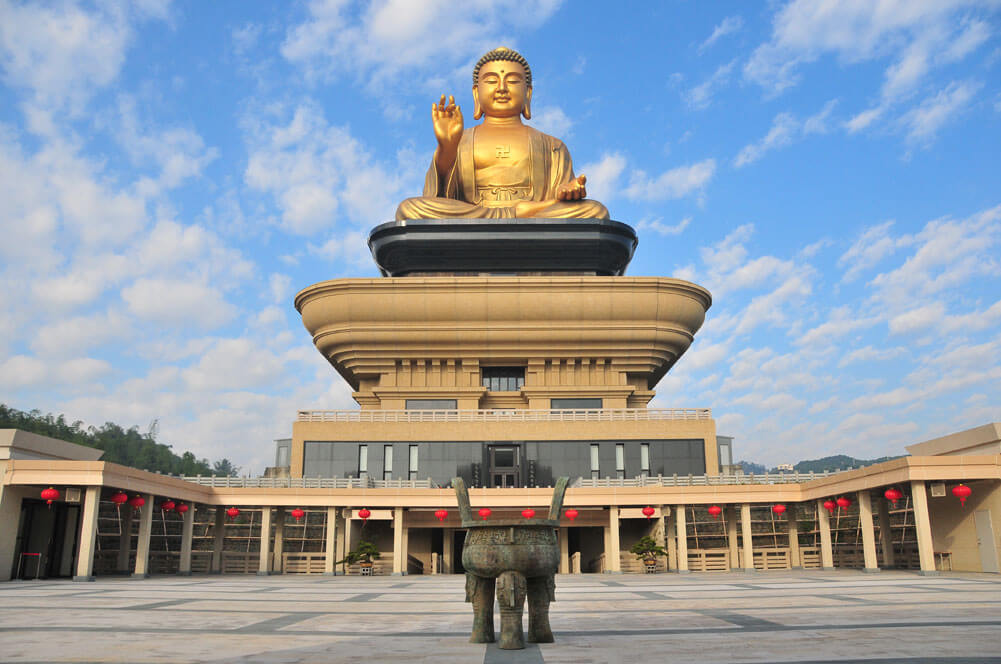
Four Noble Truths Stupas
Scan photo below to watch AR video (Download AR App)

The Four Noble Truths are an outline of the entirety of the Buddha’s teachings. Following the development of Buddhism over time, the connotations of the Four Noble Truths have expanded in correlation with the spirits of the Four Great Bodhisattvas: Great Compassion practiced by Avalokitesvara Bodhisattva, Great Vow by Ksitigarbha Bodhisattva, Great Wisdom by Manjusri Bodhisattva, and Great Practice by Samantabhadra Bodhisattva.The Four Noble Truths Stupas thus enshrine the Four Great Bodhisattvas respectively, a decision that represents an important Buddhist concept developed by Venerable Master Hsing Yun.
 Ksitigarbha Stupa
Ksitigarbha Stupa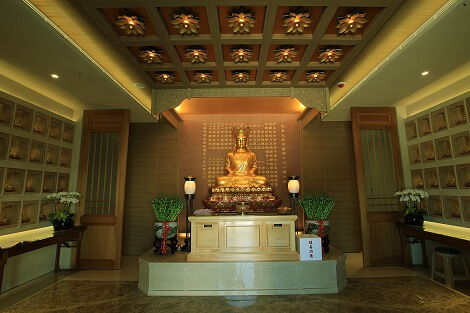 Interior of Ksitigarbha Stupa
Interior of Ksitigarbha Stupa
Visiting hours: 9 am to 6 pm daily
Group circumambulation of over 40 people can be
pre-arranged.
Meeting place: Big Buddha Terrace
Tel: 886+7-656-3033 ext. 4000, 4001
Scan photo below to watch AR video (Download AR App)

Before stepping into the Front Hall, you will see two groups of statues, one on either side of the main entrance welcoming visitors as they arrive. On the right side is an adult elephant, leading a herd of small elephants, while on the left side is a large lion surrounded by three cubs.Both the lion and the elephant have symbolic meanings in Buddhism. The elephant represents noble dignity, for the Buddha rode a white elephant into his mother’s womb. Thus, the figure of an elephant is used to commemorate the Buddha’s birthday, the day that he descended into the human world.The lion is the king of beasts. Peerless in its world, it is the ruler of its realm. In many Buddhist sutras, the lion is a metaphor for the Buddha’s fearlessness and majesty. The sound of the Buddha preaching the Dharma is known as the “lion’s roar,” for his words could wake living beings from their dreams. Then, they can finally be themselves, understanding their own lives with pure awakening.
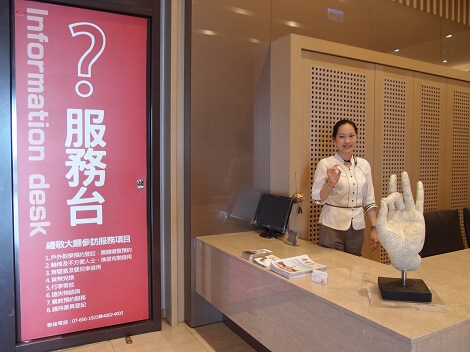 Information desk
Information desk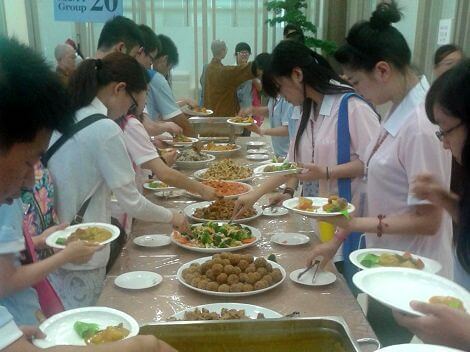 Buffet on the second
Buffet on the second
"Lijing da ting" in Chinese means “Reverence Hall”. The welcome center not only allows visitors to settle in by accommodating their physical needs, it also allows visitors to prepare their mind before they start the journey in BMC. The information desk provides general information, event schedule, left luggage service, currency exchange, special exhibitions information and maps. Wheelchair, baby stroller and guided tour service can also be arranged free of charge. There are stores on the ground floor, including gift shops, souvenir stores, vegetarian restaurants, and snacks. There is also the only vegetarian Starbucks in the world. Group dining and buffet are available on the second level during lunch hours.
 BMC souvenir store near the Gate of Ease
BMC souvenir store near the Gate of Ease Information Tower
Information Tower
Scan photo below to watch AR video (Download AR App)

While the central stupa of the Main Hall and the Four Noble Truths Stupas are constructed in the Indian “stupa” style, the Eight Pagodas on the both sides of the Great Path to Buddhahood are designed in the Chinese pagoda style. They symbolize the spread of Buddhism from India to China where it flourished. Each pagoda is 38 meters high, where you can rest your feet, enjoy a cup of tea, and discuss the Dharma with your friends.
Eightfold Path Pagoda
The Eightfold Path Pagoda is located near to the Front Hall and provides a brief introduction to the Buddha Museum. There is also a ten-minute introductory video to give visitors a better understanding of the BMC complex. Visitors who have toured the complex can also get a rest at the guest hall before they leave BMC.
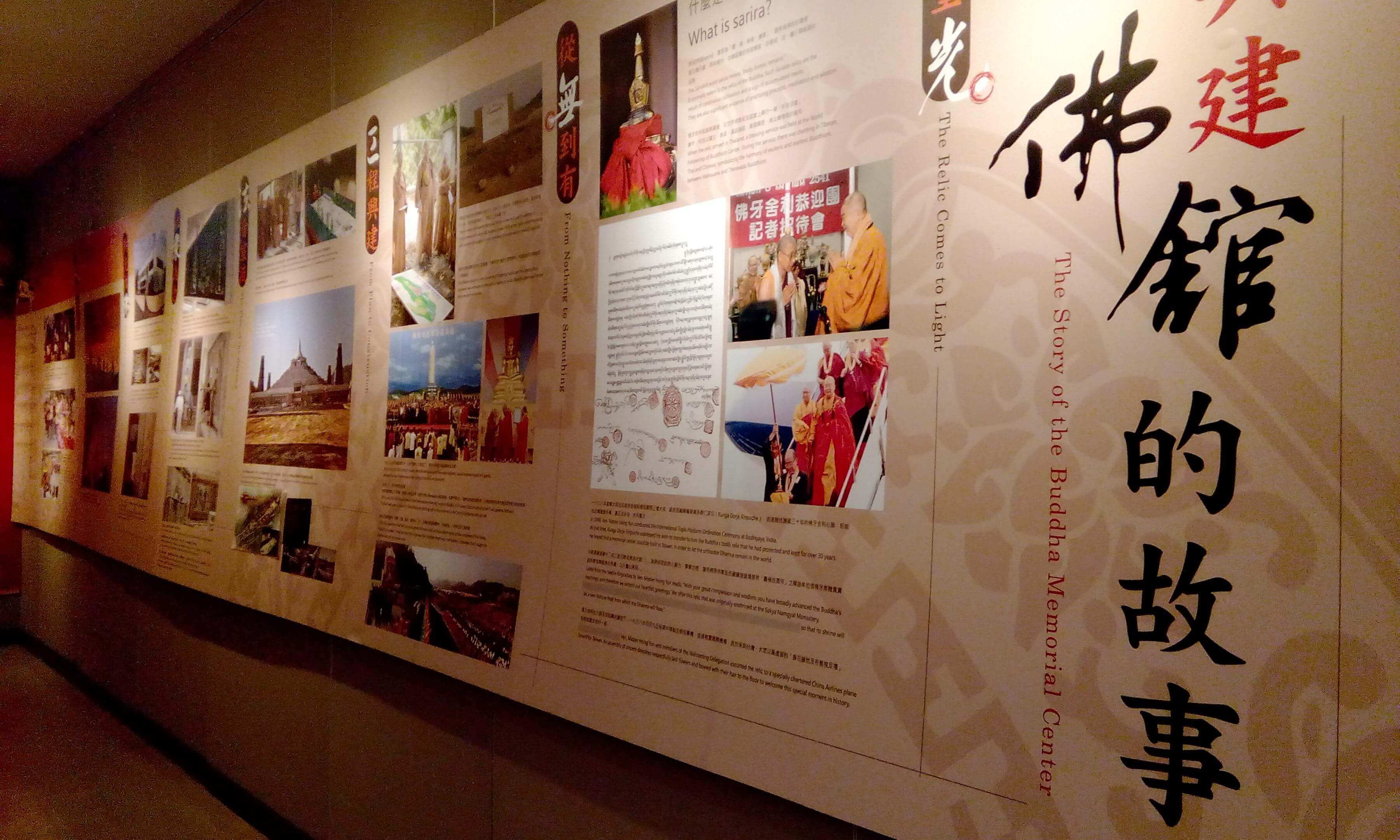 Visitors can learn more about BMC at the Eightfold Path Pagoda
Visitors can learn more about BMC at the Eightfold Path Pagoda
Six Perfections Pagoda
The Six Perfection Pagoda showcases Venerable Master's One-Stroke Calligraphy. Visitors can get to watch the hourly 3D introductory video between 9:30 am and 6:30 pm, and bring a rubbing of the One-Stroke Calligraphy home.
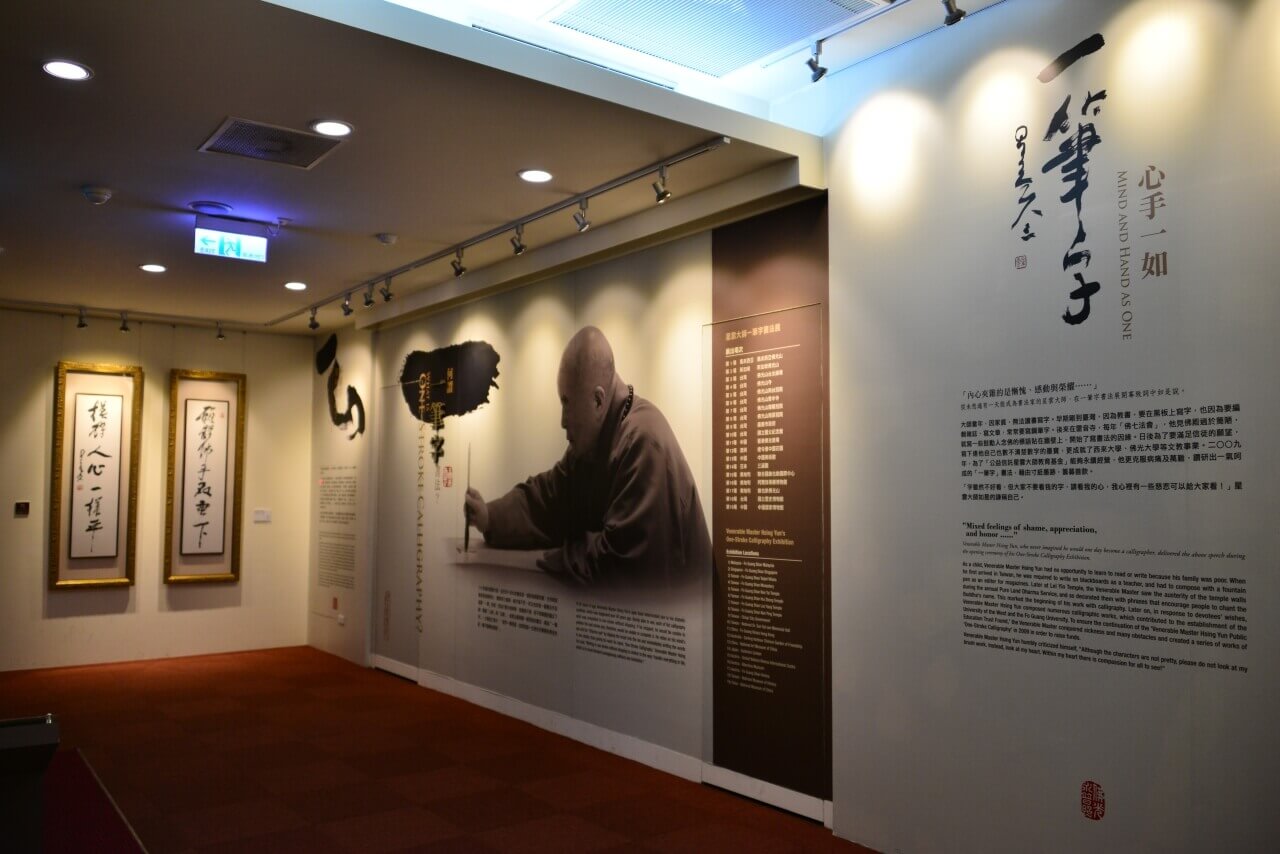 Visitors can bring home a rubbing of the One-Stroke Calligraphy
Visitors can bring home a rubbing of the One-Stroke Calligraphy
Five Harmonies Pagoda
The five harmonies refer to “personal harmony achieved through joy, interpersonal harmony achieved through respect, family harmony achieved through deference, social harmony achieved through cooperation, and world harmony achieved through peace.” The pagoda serves to celebrate family events in different ways, including Buddhist weddings, baby blessing ceremonies, and birthday celebrations. Families can also take photographs to keep as albums for remembering those joyous occasions.
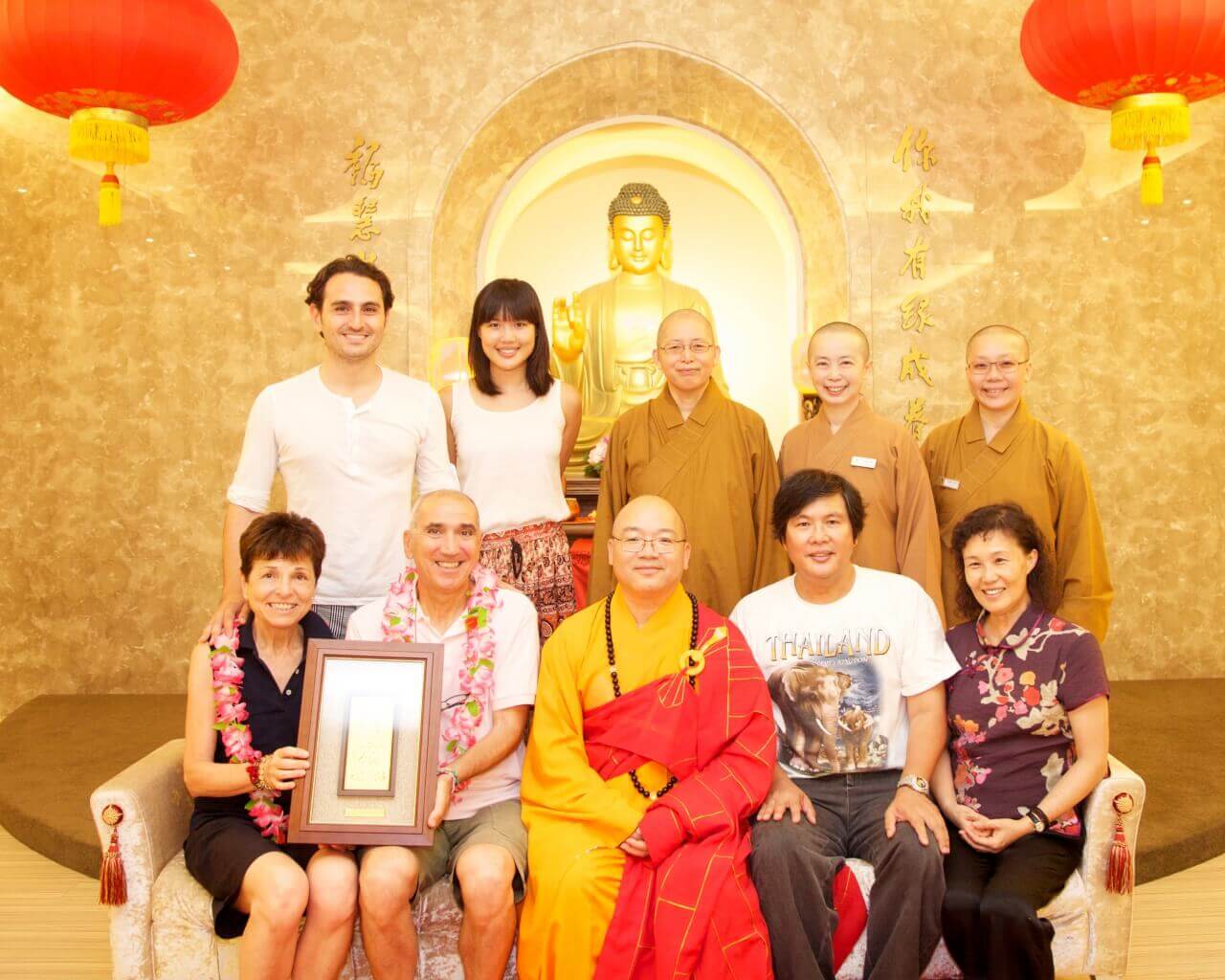 Over 300 Buddhist weddings have been held at the Five Harmonies Pagoda since 2011
Over 300 Buddhist weddings have been held at the Five Harmonies Pagoda since 2011
Four Givings Pagoda
The Four Givings Pagoda is a bookstore housing all sorts of books and multimedia published by Fo Guang Shan. Many of the books have been translated into languages including English, Spanish, Thai, and German. Here, visitors can sit and relax into the ocean of Buddhist wisdom.
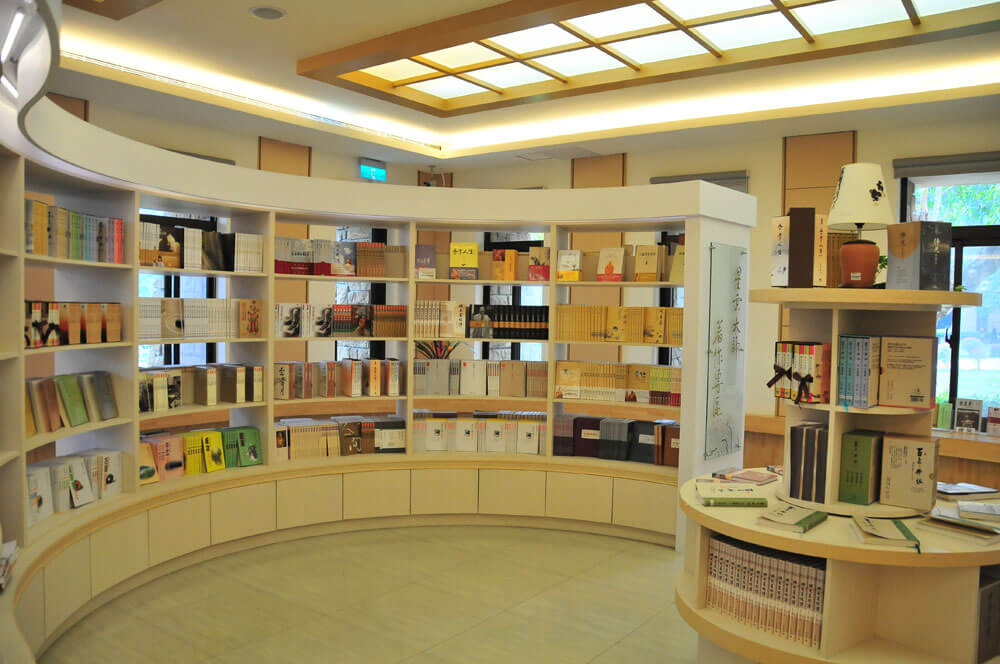 A wide collection of books available at the Four Givings Pagoda
A wide collection of books available at the Four Givings Pagoda
The Grand Photo Terrace features thirty-seven steps, representing the thirty-seven factors of enlightenment. The Grand Photo Terrace is a clever manipulation of space: the Main Hall ahead is constructed in the Indian style, while the Eight Pagodas behind are designed in the Chinese style. If you face the Front Hall, you can take a picture with the Indian-style Main Hall and the Fo Guang Big Buddha as the background. Facing the Main Hall, your picture will be set against the Chinese-style pagodas.
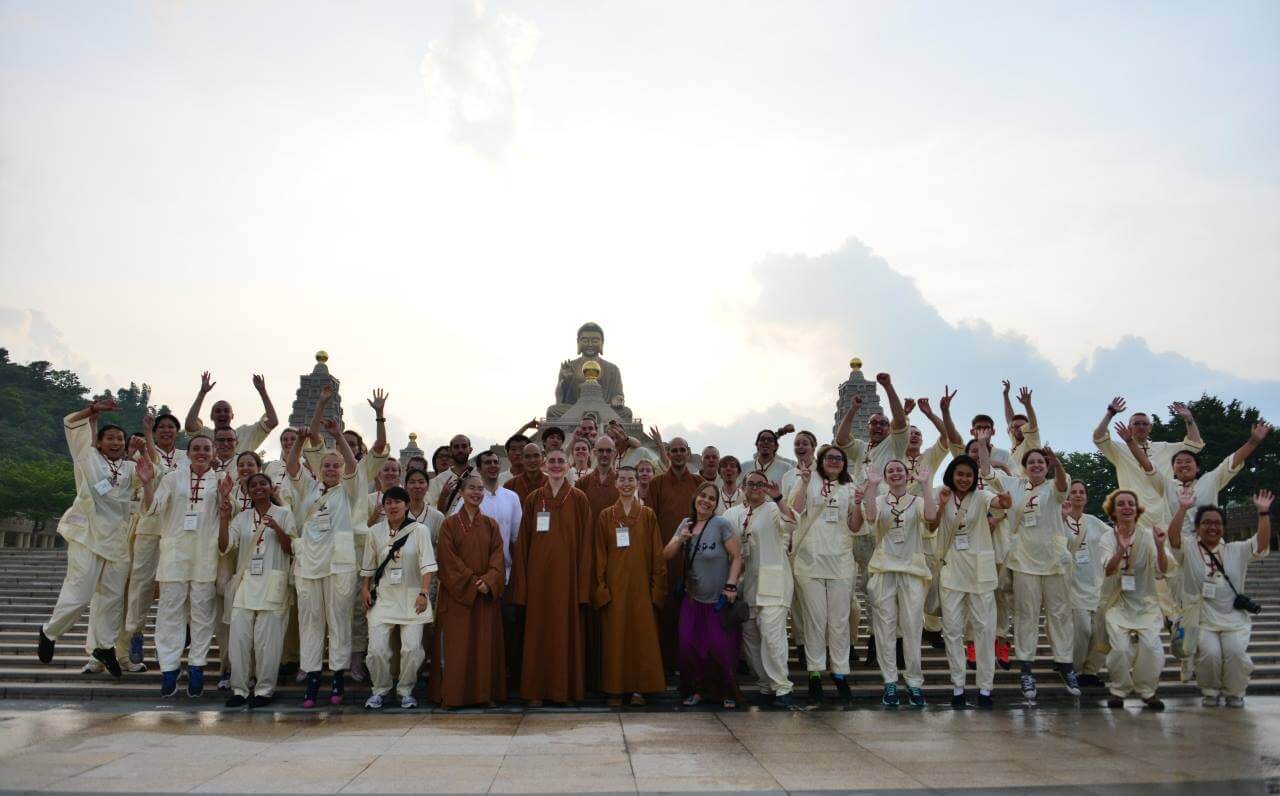 Monastics and members of the 2015 Youth Seminar of Life and Ch'an
Monastics and members of the 2015 Youth Seminar of Life and Ch'an
The Bodhi Wisdom Concourse can accommodate more than ten thousands of people and is surrounded by Madagascar Almond trees. The Eighteen Arhats are traditionally composed on male Arhats, but the Eighteen Arhats at the Bodhi Wisdom Concourse include three female Arhats: Mahaprajapati Bhiksuni, Utpalavarna Bhiksuni, and Bhadra Kapilani Bhiksuni. This revolutionary stroke of creativity not only highlights the Buddhist teaching of equality among all living beings, it also demonstrates equality between the genders.
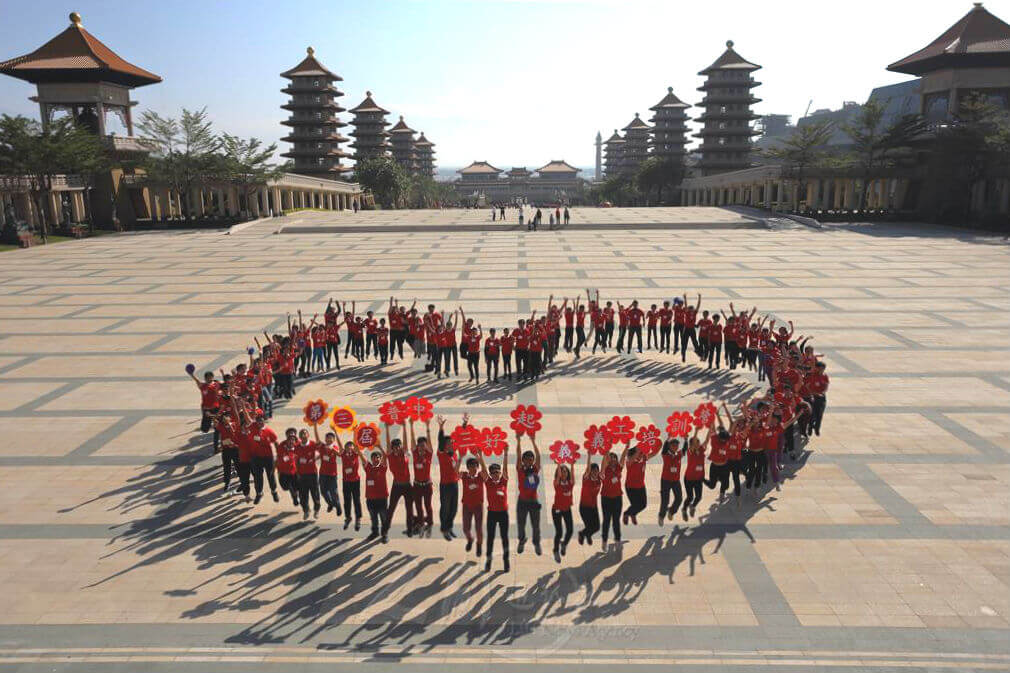 Bodhi Wisdom Concourse
Bodhi Wisdom Concourse
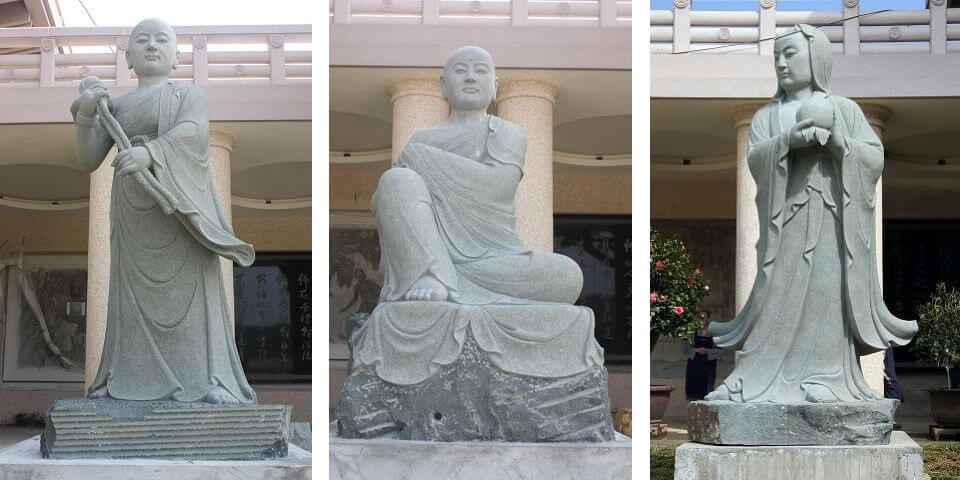 Female Arhats symbolizing gender equality as advocated by Venerable Master Hsing Yun
Female Arhats symbolizing gender equality as advocated by Venerable Master Hsing Yun
Scan photo below to watch AR video (Download AR App)

Dining options are available, including the buffet, the banquet and various Tea Houses around the Museum. Besides, each Tea House has its own characteristic, included various food, drinks, snack and beautiful scenery from different angle. (Tel: 886+7-656-3033)
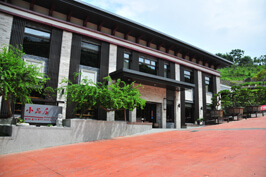
Shopping Center
Shopping Center is a place with comfortable atmosphere, including books, flowers, coffee and Chinese food.
Come here and let your mind calm down.
Tel: 886+7-656-3033 ext. 4358
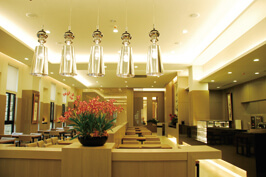
Front Hall Tea House
This Tea House is near the entrance of the Front Hall. Recommended dishes include Lima Bean Noodles, Fried Rice, and Taiwanese-style Cold Noodles.
Tel: 886+7-656-3033 ext. 4018
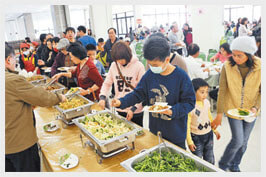
Buffet @ Front Hall 2F
This is an all-you-can-eat buffet with one meal ticket. The buffet includes ten kinds of dishes and two kinds of soups, which is cheap and delicious.
Tel: 886+7-656-3033 ext. 4021
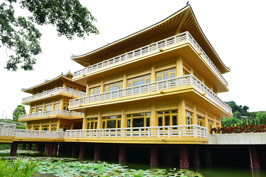
Twin Pavilions Tea House
The Twin Pavilions is an golden structure set beside a pond. Meals include noodles in soup, fried noodles, fried rice, flaky scallion pancake and many different side dishes.
Tel: 886+7-656-3033 ext. 4335
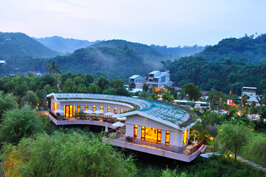
Camphor Grove Tea House
This Tea House provides a rice and a noodle dish each day, and customers can pay any price they like after the meal as a donation. The simple tea house is an unusually warm place to dine in.
Tel: 886+7-656-3033 ext. 4062
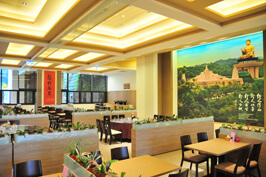
Fo Guang Building Tea House 1
This Tea House is the only restaurant under a Buddha statue in Taiwan. Many kinds of food such as Chinese food, noodles, rice, dishes, pizza, hamburgers and pancake are provided.
Tel: 886+7-656-3033 ext. 4300
The Twin Pavilions is a gold-colored structure located beside a lotus pond. The outdoors serve as an ideal spot for ecological classes. The Tea House on the first floor provides dishes including soup noodles, fried noodles, fried rice, flaky scallion pancake, as well as a variety of side dishes.
Tea Ch'an
Venerable Master Hsing Yun says that tea leaves will not be able to release fragrance without boiling water. Likewise, the fragrance of our lives arises from frustrations and difficulties. Having a peace of mind comes not only from training, but also from conducting ourselves in the society.
In a famous Chan story, Chan Master Zhaozhou would reply his disciples' questions by asking them to drink a cup of tea. Tea is closely related to Chan, and it helps to dissipate fatigue. At the Twin Pavilions, Tea Chan sessions can be arranged for interested groups and organizations.
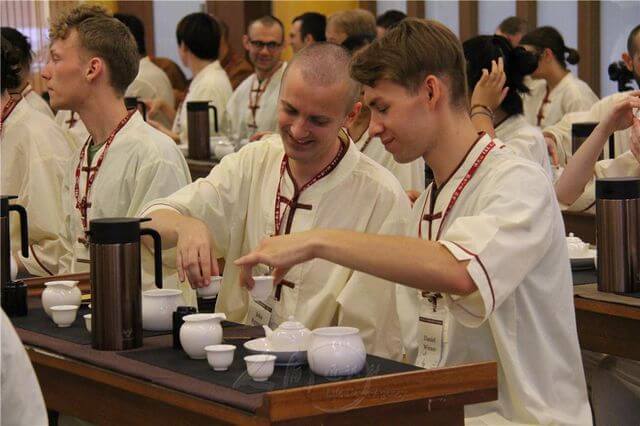
Sutra Transcription
Apart from Tea Chan, one can also experience Sutra Transcription on the third floor. Sutra Transcription is adapted into Buddhism from Chinese calligraphy in the early days before printing was available. In order to make Buddhist scriptures more accessible to others, scribes were engaged to transcribes the sutras. Over time, it became a way of cultivation, through which one calms the minds and deepens the understanding of the Dharma.
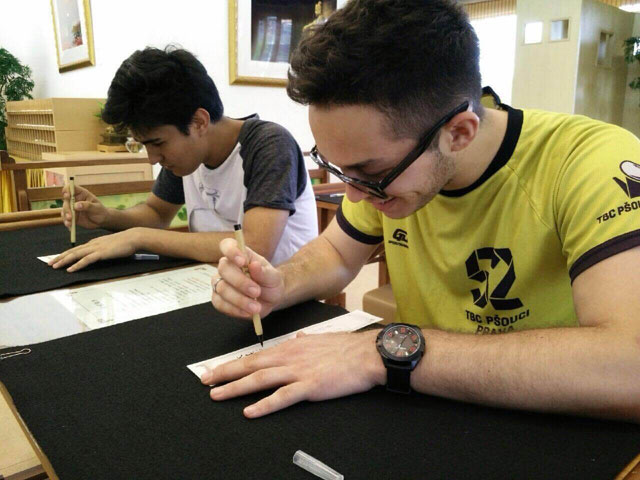
Scan photo below to watch AR video (Download AR App)

Opening Hours:
Weekdays: 9 am to 6 pm
Weekends: 9 am to 7 pm
Main Hall is the main building in Buddha Memorial Center dedicated to Sakyamuni Buddha, the root teacher of all Buddhists. This is also the place where the Buddha’s tooth relic is enshrined.
On the first floor of Main Hall, there are three shrines and four permanent exhibits. The architecture and presentation of the Main Hall not only combines Indian and Chinese culture, it is also a successful integration of past and present. With multimedia presentation, people can easily understand and accept the Buddha’s teachings. On second floor, there are four art galleries.
Avalokitesvara Shrine
Scan photo below to watch AR video (Download AR App)

The Thousand-Armed, Thousand-Eyed Avalokitesvara Bodhisattva statue at the center is sculpted by Loretta Yang Huishan, whose artistic creations are made with the lost-wax process of glass casting. The shrine contains thirty-three images of Avalokitesvara Bodhisattva set in a circle. Clear, bright mirrors are set on the four surrounding walls. Images are reflected on each other by the mirrors, creating an unbroken continuity with layer upon layer of images stretching far and near.
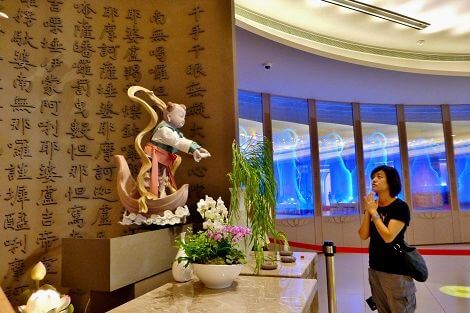 Wishing for water consecrated by the Great Compassion mantra
Wishing for water consecrated by the Great Compassion mantra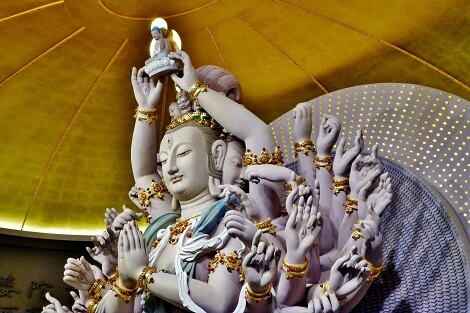 Thousand-Armed, Thousand-Eyed Avalokitesvara
Thousand-Armed, Thousand-Eyed Avalokitesvara
Golden Buddha Shrine
Scan photo below to watch AR video (Download AR App)

The Golden Buddha Shrine houses the tallest seated golden Buddha statue in Southeast Asia. The statue is presented by the Thai Sangharaja, signifying the harmonious exchange between the Mahayana and Theravada traditions. Surrounding the Golden Buddha Shrine, there are over 6,000 small Buddha statues in the wall niches. Lotus patterns carved on the ceiling enhance the dignity of the shrine. The four pillars in the shrine are carved with various Mahayana sutras. After worshiping the Buddha, visitors can also seek aphorisms and words of advice from the “Dharma Word Boxes.”
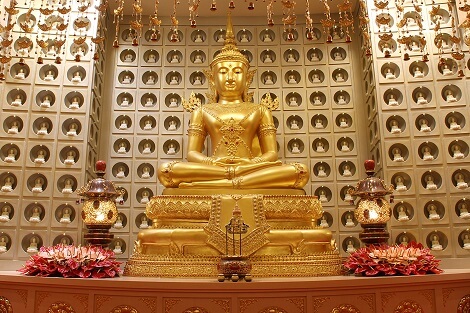 Golden Buddha statue from Thailand
Golden Buddha statue from Thailand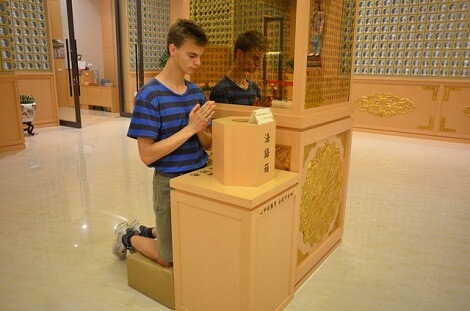 Seeking a piece of Dharma advice
Seeking a piece of Dharma advice
Jade Buddha Shrine
Scan photo below to watch AR video (Download AR App)

The Jade Buddha Shrine houses an image of the reclining Buddha, carved out of precious white jade from Burma. The treasured Buddha’s tooth relic is enshrined above the image. It is one of the three Buddha’s tooth relics in the world. On two sides of the Jade Buddha statue are magnificent jade relief carvings. Arrayed along the walls to the left and right are wooden relief carvings of famous Buddhist stupas from around the world.
The Jade Buddha Shrine is free to visit from 9:00 to 10:30 and 17:00 to 18:00 (or 19:00 on weekend). From 11:00 to 16:00, a 30-minutes cultivation including meditation, chanting and Buddhist talk that leading by monastic will be held hourly in Jade Buddha Shrine.
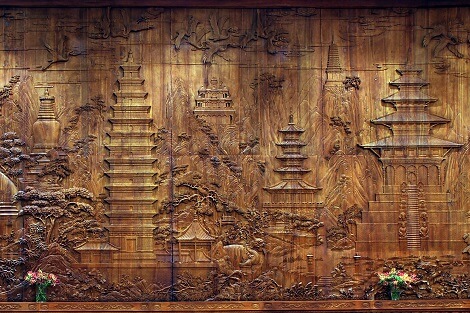 Famous stupas etched into aromatic wood
Famous stupas etched into aromatic wood Jade relief carvings of the Western Paradise
Jade relief carvings of the Western Paradise
Main Hall (First Floor) - Permanent Exhibits
Museum of Buddhist Festivals
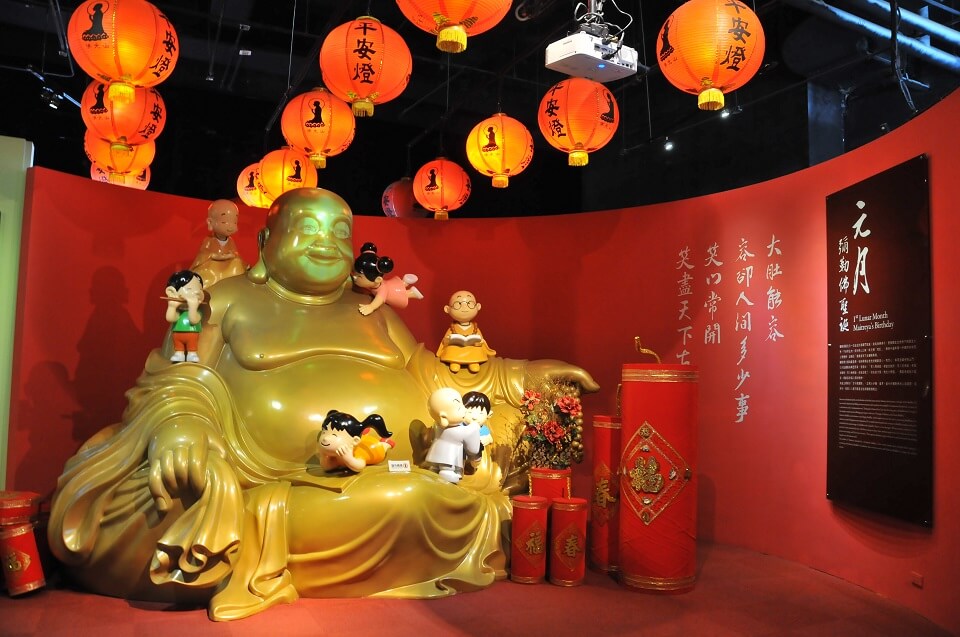
The Museum of Buddhist Festivals is where visitors can get to know more about monthly Buddhist celebrations. Visitors can walk through the year, engaging in the events through interactive means. During the 11th lunar month, for example, visitors can make a lamp offering to the Medicine Buddha. At the end of the journey, one can also take home a blessing directly placed in one's palms.
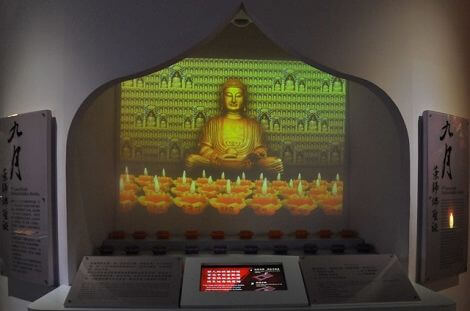 Visitors can make a light offering to the Medicine Buddha
Visitors can make a light offering to the Medicine Buddha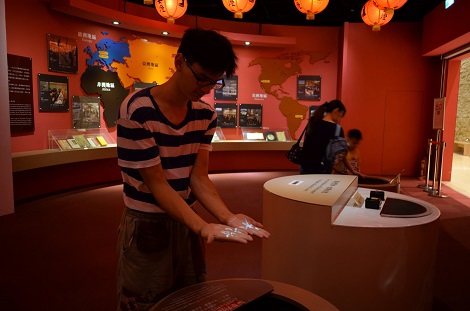 Visitors can also take home a blessing
Visitors can also take home a blessing
Life of the Buddha Museum
The first attraction upon entering the exhibit is the “4D Movie Theater.” There are two movies, “Poor Girl’s Lamp” and “Life of the Buddha” playing in the theater every half hour. “Life of the Buddha” is played from 10:00 to 12:30, and “Poor Girl’s Lamp” is played from 13:00 to 17:00 (18:00 on weekend). Upon exiting the 4D movie theater, visitors can walk through the stages of the Buddha’s life.
Shows:
Life of the Buddha: 10:00-12:30 (half-hourly)
Poor Girl's Lamp: 13:00-17:00 (half-hourly)
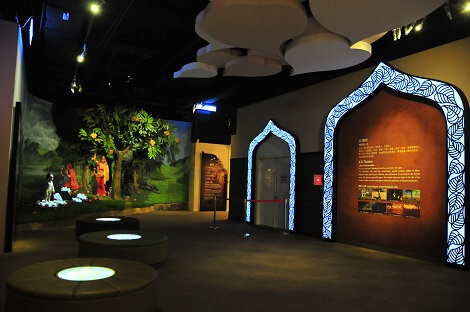 The 4D show is available every half an hour. Tickets available at the counter.
The 4D show is available every half an hour. Tickets available at the counter.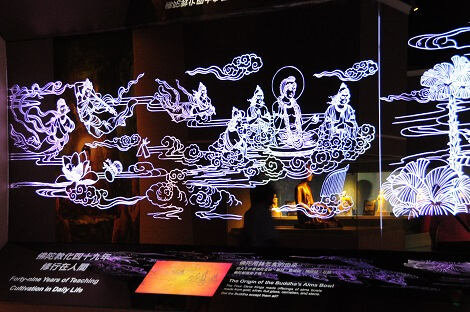 The Buddha's 49 years of teaching after enlightenment
The Buddha's 49 years of teaching after enlightenment
Historical Museum of Fo Guang Shan
The Historical Museum of Fo Guang Shan employs narrative videos and displays documents and artifacts to give a smooth and fluid presentation of the development of Venerable Master Hsing Yun’s philosophy. The museum also demonstrates how Fo Guang Shan implements the down-to-earth, beneficial-to-others, and contemporary-oriented qualities of Humanistic Buddhism.
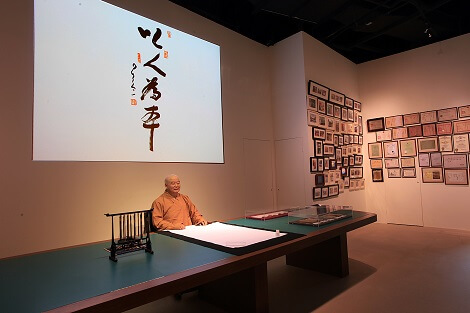 A statue of Venerable Master at his working desk
A statue of Venerable Master at his working desk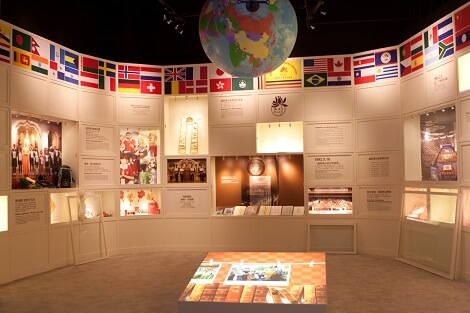 Buddha's Light International Association reaches out to places around the world
Buddha's Light International Association reaches out to places around the world
Art Galleries (2nd Floor)
The Venerable Master Hsing Yun has said that people cannot live without the sense of art, so does religion. There are four galleries on the second floor of the Main Hall, including current exhibitions, which exhibit famous artists’ artwork.
See More Information under Exhibitions
 Free exhibitions at
the Museum have attracted numerous visitors over the years
Free exhibitions at
the Museum have attracted numerous visitors over the years Venerable Ru Chang shows how visitors can guide themselves using an APP
Venerable Ru Chang shows how visitors can guide themselves using an APP
Great Enlightenment Auditorium
Scan photo below to watch AR video (Download AR App)

The high-vaulted “Great Enlightenment Auditorium” on the second floor of the Main Hall combines the idea of a theater with that of a place for religious cultivation. All the scenes in the Great Enlightenment Auditorium are dynamic, as if one were in the midst of the Buddha land. Visitors who come here often bring home a sense of peace and joy.
 Free performances at the Great Enlightenment Auditorium
Free performances at the Great Enlightenment Auditorium Viktor Mayer-Schonberger giving a speech on Big Data
Viktor Mayer-Schonberger giving a speech on Big Data
There are twenty-two bas-reliefs made by sculptor Shi Jinhui set in the walls lining the walkways on either side of the Bodhi Wisdom Concourse. Each depicts a story from the Buddha’s life. They tell the stories of how the Buddha went out among the people and applied his wise and compassionate mind to transform society at every level. There are also twenty-two Buddhist Verses written by Venerable Master Hsing Yun as one stroke calligraphy.
Scan photo below to watch AR video (Download AR App)

Because Buddha was born as a human, cultivated himself according to a religious doctrine, became Buddha and purified people in human life, he tried to teach people to learn and to follow the Dharma in order to liberate themselves from human lives . If you want to learn more, the pocket books about the Stories of the Buddha are available at the Four Givings Pagoda.
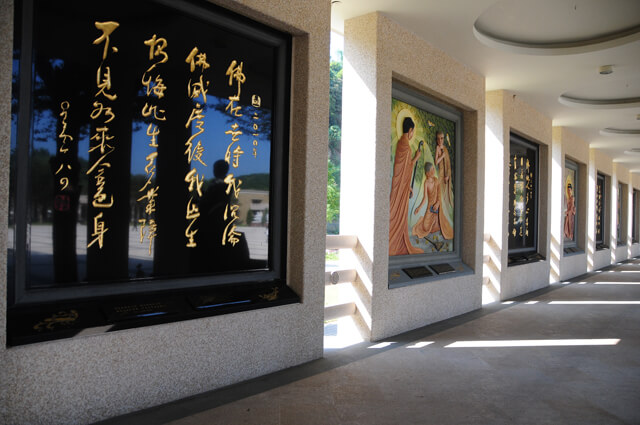
In 1993, the well-known painters from Mainland China, GaoErtai and his wife, Pu Xiaoyu used the content of Hsing Yun’s Chan Talk as material for one hundred paintings during their stay at Hsi Lai Temple. The sculptor Ye Xianming and the painter Chan Mingqi recreated them as a series of forty bas reliefs. These are on display along the outer walls of the northern and southern walkways.
Scan photo below to watch AR video (Download AR App)

The Eight Winds Cannot Move Me
Su Dongpo was a Song Dynasty poet and government official in Guazhou. Though the Yangzi River separated Guazhou from Jinshan Temple, Su Dongpo crossed it regularly to converse with the temple’s abbot, Chan Master Foyin, about Chan and the Way. One day, when Su Dongpo felt that his cultivation had reached full maturity, he composed the following poem and dispatched his young attendant to deliver it to Master Foyin for his approval: Bowing, Heaven within Heaven, I am the light that illuminates the boundless universe. The eight winds cannot move me, who am seated mindfully upon the purple golden lotus.Upon reading it, the master dashed off a one-word comment for the young attendant to carry back. As soon as Su Dongpo read “fart” an uncontrollable anger began to rise. So he embarked for the other shore to debate the master. As his boat approached Jinshan Temple, Master Foyin was already waiting. Su Dongpo said, “We are the closest of Dharma friends. My poem, my cultivation – if you don’t praise it, that’s fine. But how could you insult me?” Acting as if nothing had happened, the Chan master asked, “How did I insult you?” When Su Dongpo showed him his comment, the master roared with laughter, saying, “Didn’t you say ‘the eight winds cannot move me?’ So how come a fart has blown you across the river?”
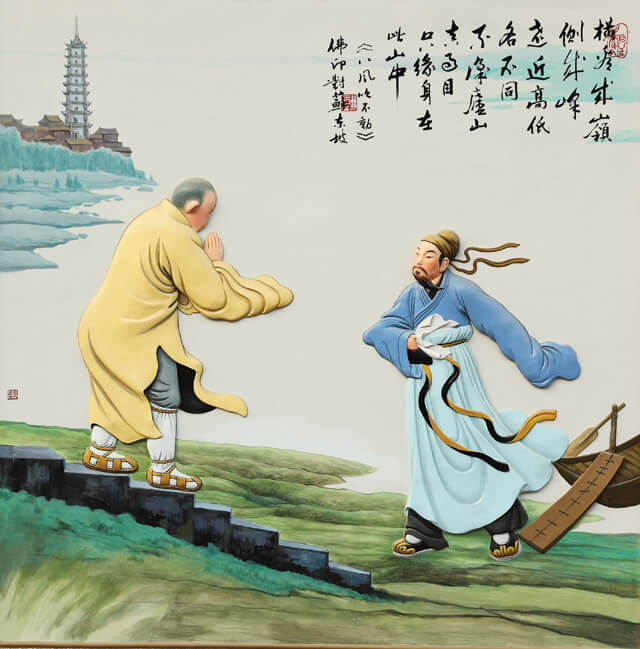
No One Can Take Your Place
Chan Master Daoqian and his friend, Zongyuan, embarked on a very long journey for the purposes of study and of paying visits. But Daoqian complained incessantly of exhaustion brought on from crossing so many mountains and rivers, and he wished ardently to turn back. Zongyuan tried to comfort him, saying, “We have pledged to go forth to study, and we have already walked halfway. It would be a real shame to quit now. Here is my plan: if there is anything I can do for you, I certainly will, with the exception of five things that I cannot help you with.” “What are the five things?” asked Daoqian. “Dress, eat, shit, piss, and walk,” Zongyuan answered. Hearing this, Daoqian had a great awakening, and never again spoke of hardship. There is a saying: “Even when gold floods in with the tide, you must rise early to collect your share!” In this world, you achieve nothing without strenuous effort. A hundred-story tower begins at the ground. A thousand-mile journey starts with the first step. Be willing to bear your own afflictions here, in this mire of birth and death. No one can suffer in your place!
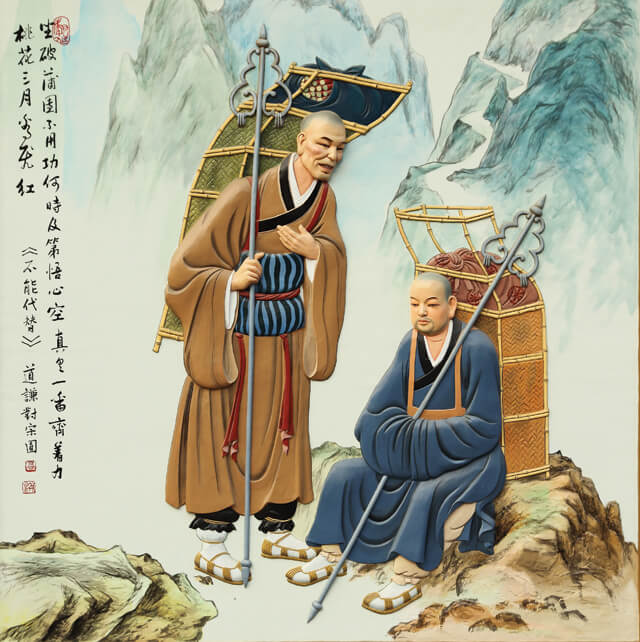
The Moon Cannot Be Stolen
When he was not propagating the Dharma, Zen Master Ryokan lived very modestly in a crude thatched hut at the foot of a mountain. One night, as he returned from teaching the sutras, he surprised a thief in his hut. The thief was scared and confused. Ryokan kindly said to the empty-handed thief, “Can’t find anything to steal? I think you made this trip in vain. How about this? Take the robe I am wearing.” The thief snatched the robe and fled. Zen Master Ryokan, standing with his innerwear in the moonlight, watched the retreating figure of the thief and sighed with infinite regret, “It is a pity I cannot give him this beautiful moon!” The moon cannot be stolen, nor can we be robbed of our most precious treasure – our Buddha nature. Everyone can enjoy the rich bounty of nature without fear of losing it. Why, then, would anyone degrade himself by becoming a thief?
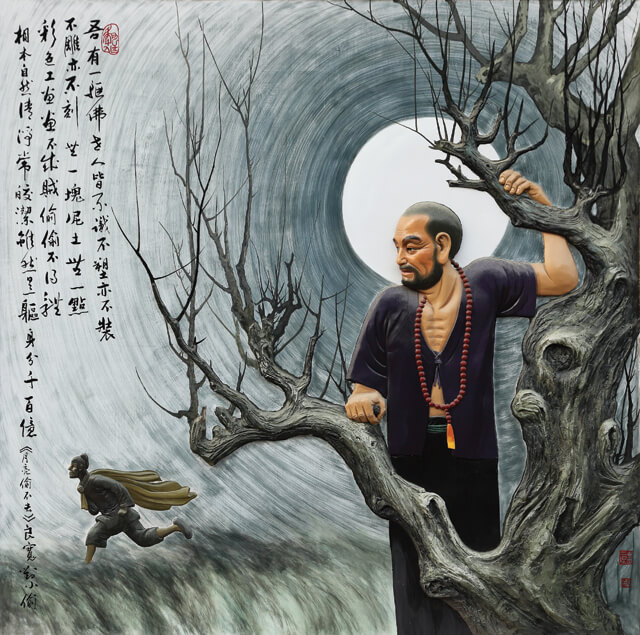
If you want to learn more, the pocket books about Chan Art and Stories are available at the Four Givings Pagoda
Tel: 886+7-656-3033 Ext. 4140
The biggest bas-relief artwork is on the wall of southern and northern walkways of Buddha Museum. On the wall, there are Life Protection Murals by Feng Zikai, Chan Art and Stories by Gao Ertai and his wife, Pu Xiaoyu and Fo Guang Cai Gen Tan (Roots of Wisdom) by famous painters.
Scan photo below to watch AR video (Download AR App)

The eighty-six color murals depicting the protection of life were selected from Feng Zikai’sProtection for Living Beings, and are arrayed along the outer walls of the long walkway. The murals emphasize the sanctity of life. Parents can bring their children along to appreciate the murals and develop their sense of compassion, which will have a positive effect on their growth. Some of the poems and calligraphy were written by Venerable Hongyi, an eminent monk of the early Republican era. Apart from Life Protection Murals, there are Fo Guang Cai Gen Tan (Roots of Wisdom), which were written by various artists set to teach people some wisdom.
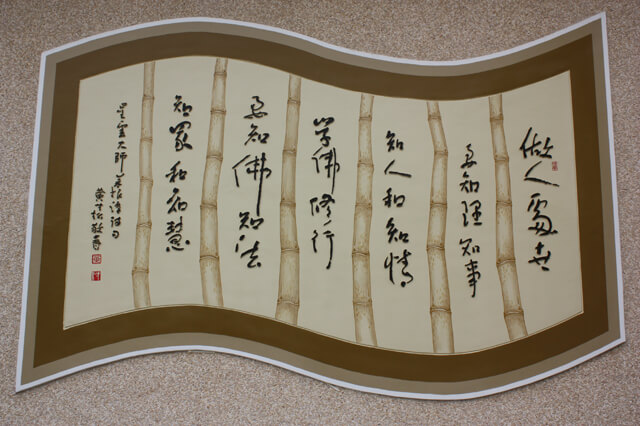
Playing with butterflies or other bugs is such an innocent game. However it most probably will hurt these little insects. Kids should be taught not to harm any living beings from an early age. These works also emphasize environmental protection and preserving the earth's resources.
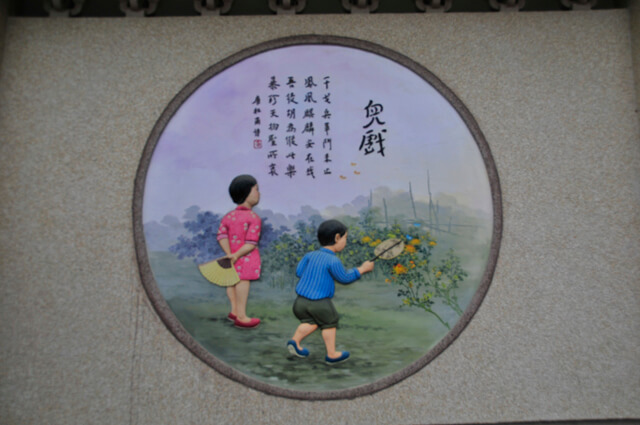
If you want to learn more, the pocket books about Life Protection Murals are available at the Four Givings Pagoda.
Tel: 886+7-656-3033 Ext. 4140

